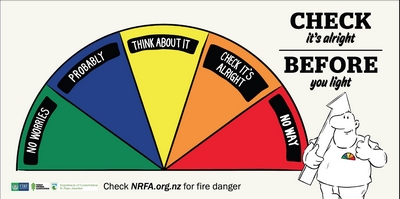What do Fire Danger Signs Mean
14 January 2015
Summertime and the living is easy, fish are jumping and the fire danger is high. But what do the familiar roadside fire danger signs really mean?
Clear, colourful and simple, the signs’ message is not as obvious as it seems. The Scion Rural Fire Research Group is working with the National Rural Fire Authority after a study found that many people are not sure what the danger ratings mean, or if they apply to them.
Lisa Langer, the fire scientist who led the work, explains: “We wanted to see if the fire danger warnings influenced people’s behaviour and encouraged safer fire practices.
“We interviewed locals, and New Zealand and international visitors in Canterbury and Northland and asked them what the fire danger signs meant to them.
“On the plus side, most people are aware of the signs. But some of our results were surprising.
“Perhaps most worrying is that one person in five felt the signs didn’t apply to them; that they were for others, like smokers or campers or ‘reckless people’.
“And two thirds of people we talked to said that that the signs did not alert them to the possibility that that they might need to change their behaviour. People were also very uncertain as to what they should or shouldn’t do at each fire danger level, other than for low or extreme.
“We also found that the signs were not particularly effective for visitors. This is a specific concern in summer when people are moving around the country and the fire danger is often very high or extreme.
“The challenge is to get people to take notice of the fire danger signs; to make them aware of local conditions, and what they can do to prevent wildfires from starting.
"Rural Fire Authorities, led by the National Rural Fire Authority, have responded to these research findings by developing new TV advertising, YouTube clips, roadside signs and some FireSmart activities. The emphasis is now ‘Check it’s alright before you light’.”
Further work by the Rural Fire Research Group has focussed on how to communicate wildfire messages more effectively. “We considered who was using fire, what they needed to know about fire risk, restrictions and other actions to prevent fires, as well as being prepared for a fire if one should occur,” says Lisa.
“Most people are not fire users, but that can change on holiday. It is holidaymakers who do things like light campfires and set off fireworks that could start a wildfire. And holidaymakers tend to be visitors to an area. One of the real communication challenges is to increase the awareness of visitors to the local fire danger in the area they are in.
Lisa’s advice for a safe summer is:
- Find out about current fire danger and fire restrictions in your area and areas you might be visiting by contacting your local Rural Fire Authority or council, or check out the National Rural Fire Authority’s website – www.nrfa.org.nz.
- Don’t park vehicles on dry flammable material like long grass. One in every six wildfires is started by a vehicle.
- Leave fireworks at home. Incendiary devices cause at least 6% of wildfires.
Check whether you are able to use solid fuel barbecues, braziers or campfires. These are generally not allowed to be used during Restricted or Prohibited fire seasons." - Be careful with cigarettes, matches and lighters.
- Remember, if you are found to be responsible for starting a wildfire, you could have to pay the cost of putting it out and for any damage incurred.
- It’s also a very good idea to carry a fire extinguisher in your car or pack one with your camping gear.
And if you have any doubt as to whether you should light a camp or beach fire – don’t! - If you see or start a wildfire, call 111 immediately, and make sure you and others are safe. Wildfires can spread very quickly, sometimes faster than people can run.

Wildfire in New Zealand
Virtually all of the more than 3000 wildfires reported each year are started accidentally or deliberately by people. Natural causes like lightning account for less than 1% of wildfires.A review of 15 years of New Zealand wildfire statistics by Scion fire researchers found 20% of wildfires are the result of land clearing burns getting out of control, a further 17% are started by vehicles, 6% by fireworks and firearms, and 3% by recreational fires. The actual number of fires started by these causes is likely to be higher, as the cause of roughly half of all wildfires is classified as unknown or miscellaneous.
Wildfires burn close to 6000 ha of land each year on average, an area the size of greater Auckland. However, this can be much greater in very dry years.
The areas at the greatest risk from wildfires are the drier regions of the east coasts of both islands (Marlborough, Canterbury, central Otago, Hawke’s Bay and the East Coast) and Northland. Slightly more than half the area burned each year is grassland, scrubland makes up most of the rest, with forests accounting for just 6%.
More fires occur in the North Island, but a greater area of the South Island’s dry, grassy plains is burnt.
ENDS
